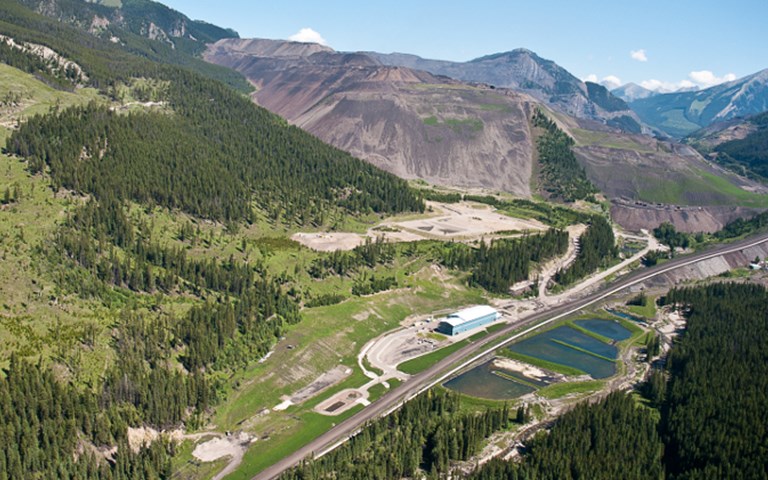Mines that will require long-term water treatment, including Teck’s Elk Valley coal project, made up the majority of the B.C. mines ministry’s reclamation fund shortfall. Courtesy of Teck Resources
The British Columbia mines ministry lacks a “culture of enforcement,” according to an audit released in May from the provincial auditor general’s office. In a press release announcing the report, Auditor General Carol Bellringer said “almost every one of our expectations for a robust compliance and enforcement program were not met.” The report examined the activities of both the Ministry of Energy and Mines (MEM) and the Ministry of Environment.
The report noted MEM might be at risk of regulatory capture – when a regulatory agency focuses on supporting the industry it regulates over the public’s interest – and recommended compliance and enforcement activities be removed from the ministry. Instead, the audit advised, these tasks should be governed by an independent unit.
The recommendation was the only one the government did not unequivocally accept. “This recommendation suggests that the public servants in MEM are incapable of differentiating between promotion and regulation of mining, a view government does not share,” the environment and mining ministries stated in a joint written response to the report. “We do not accept that mere appearances are sufficient to warrant the act of removing compliance and enforcement from MEM.”
Nonetheless, the release said MEM will establish a separate board within three months, to “strengthen government’s regulatory oversight of the mining sector” and bridge the mining and environment ministries and the provincial Environmental Assessment Office.
“The overall recommendation we feel is the foundation for a sound program,” said Morris Sydor, an assistant auditor general for the province. He noted that other jurisdictions had identified regulatory capture as an issue after environmental and safety disasters, including in Nova Scotia after the 1997 inquiry into the Westray mining disaster, which led to the creation of the province’s 2003 Underground Mining Act (updated again in 2008).
Sydor said he hopes the report will be brought forward before legislators so the ministry can further explain why they are planning to “go a different direction.” MEM spokesperson David Haslam noted that the ministry does not believe its compliance and enforcement regimes place the environment at risk. (The government accepted all of the 17 additional recommendations.)
The report also focused on an estimated $1.2-billion shortfall in the fund designed to cover future reclamation costs. The provincial Mines Act requires companies give the government a full or partial security deposit, based on estimated liability calculations, to ensure the province will not be financially responsible for future reclamation costs. (“Statutory decision-makers,” not the minister, determine the amount of the security bonds required for each mine, Haslam said. The ministry can review and update the amounts as necessary.) Many companies, however, have not deposited enough to meet the estimated liabilities.
“With the [environmental] risks increasing, you might not know when you design the mine that you need a water treatment plant ten years down the road,” said performance auditor Tanya Wood. If a water treatment plant is eventually needed, the ministry will reassess the liability amount. “To go back and get that money from the mine can be quite challenging,” she said.
On May 18 the Vancouver Sun released a detailed list of companies that contribute to the audit’s assessed reclamation fund shortfall with outstanding financial security deposits. That list identified Teck’s Elk Valley coal project as one of the major contributors to the deficit, with a gap between estimated and actual liability coverage of more than $500 million. Teck’s Highland Valley Copper mine and Barrick’s Eskay Creek gold project also had significant gaps: more than $186 million and $114 million, respectively. Over half of the sites listed had no shortfall; many gaps were less than $1 million.
Barrick will have enough to cover the closure costs at Eskay Creek, said Barrick senior vice-president of communications Andy Lloyd, and the money is already set aside. “We do have on our books roughly $114 million for provisions for environmental remediation for the closure sites,” he said. “We continue to fund those activities on an ongoing basis.
“Barrick has a significant amount of liquidity to cover all of our obligations – certainly our closure obligations – and we have a good track record.”
Mines that will require water treatment – including Elk Valley – are responsible for $730 million of the shortfall. “This is contrary to MEM’s policy requiring full security on mines that require long-term water treatment,” the audit stated.
Haslam said MEM increased the amount of reclamation securities it holds over the years, doubling the amount since 2011 and quadrupling it since 2001.
The provincial government also highlighted Teck’s efforts to treat selenium in the waters at Elk Valley, noting the company has committed to building eight new water treatment facilities.
Mount Polley’s liability shortfall was estimated at just under $10.5 million. The August 2014 tailings breach at the mine was specifically highlighted as part of the audit’s rationale for the recommendation to remove compliance and enforcement from MEM’s jurisdiction.
“We found that the ministry did not ensure that the tailings dam was being built or operated according to the approved design, nor did it ensure that the mining company rectified design and operational deficiencies,” the report stated.
The audit also found that MEM did not have enough human or financial resources to conduct the required inspections. The ministry has challenged the audit’s interpretation of its role at Mount Polley, stating that it “does not align” with the conclusions of the Mount Polley independent review panel or Chief Inspector of Mines Al Hoffman’s investigation.
Other recommendations in the audit included creating incentives to promote responsible behaviour among mining companies, formulating reclamation guidelines and enacting new reporting policies for enforcement activities and the security deposits.
The report took about two years to complete and examined the three years between 2012 and 2014.




